2. 中国船舶重工集团公司 第七〇三研究所, 黑龙江 哈尔滨 150078
2. The 703 Research Institute of China Shipbuilding Industry Corporation, Harbin 150078, China
在渤海等覆冰海域,海冰会受风力、潮流力等作用发生漂移,在与柱状结构作用的过程中,海冰可能出现劈裂、挤压以及屈曲等破坏模式,其中挤压破坏最为常见。同时,此作用过程中极易形成交变载荷,引发结构振动。当前对于这种振动的机理解释大致可分为2类观点:1)认为冰激振动是一种强迫振动,实质是一种共振现象,与冰的破坏长度有关[1];2)认为冰激振动是一种自激振动,实质在于能量供给与耗散之间的平衡关系。典型的自激振动模型是Maattanen[2]提出的负阻尼模型。
海冰与海洋结构相互作用的研究主要有理论方法、试验方法和数值模拟3种方法。数值方法凭借其应用灵活、成本低廉且效率高等优势,应用逐渐趋于广泛。其中,在有限元(FEM)方法应用领域,Martonen等[3]应用ANSYS对层冰与刚性锥体结构的作用进行了非线性有限元模拟,其中冰的破坏采用多面失效准则判断;Hilding等[4]应用内聚力单元法对冰与直立结构的相互作用进行了研究;武文华等[5]应用LS-DYNA计算了海冰与JZ20-2NW北高平台的相互作用过程中的动冰力和平台振动响应;龚榆峰等[6]应用ABAQUS的UEL平台开发出模拟失效的海冰单元,通过冰排与斜坡、圆锥结构相互作用算例进行了验证。而在离散元(DEM)方法应用领域,Paavilainen等[7]运用二维DEM方法模拟了冰与斜板作用下破碎、堆积现象,研究了作用过程中冰载荷和碎块形状特点;Lau[8]运用三维离散元方法模拟了冰排与锥体桥墩的相互作用,并同模型试验结果进行了对比验证;狄少丞等[9]基于GPU并行算法,根据梁单元理论构建海冰粘结模型,模拟了海冰与直立、锥体等平台结构的相互作用;邵帅等[10]采用DEM-FEM耦合算法模拟冰-结构相互作用,采用DEM模拟海冰的破碎,同时运用FEM计算平台结构的振动响应。
近场动力学(peridynamics,PD)理论由美国的Silling教授提出,并给出了相应的数值算法[11-12]。与经典连续介质力学不同,近场动力学基于非局部作用思想,采用积分型控制方程进行求解。其避免了传统数值方法中连续性假设和求解偏微分方程的困难[13],在求解材料的裂纹扩展等非连续性问题上优势较为明显,在混凝土、复合材料等破坏问题的分析上取得了良好的效果[13]。
本文采用键型近场动力学方法(bond-based perdynamics),模拟了海冰与柱状结构的相互作用过程。通过建立PD模型,同时考虑结构振动的影响,将单自由度振动方程加入到结构的位移计算中,求解相互作用过程中冰载荷和柱状结构的振动响应,将结果同文献[14]中离散元方法的计算结果进行对比以验证其合理性。讨论分析了桩径和冰速等参数对冰载荷和结构振动响应的影响。
1 近场动力学理论如图 1所示,对于某一时刻t下占据空间区域R的物质体,其动力学控制方程为:
| $ \begin{array}{l} \rho \ddot u(\mathit{\boldsymbol{x}}, t) = \int_{{H_x}} \mathit{\boldsymbol{f}} \left( {\mathit{\boldsymbol{u}}\left( {\mathit{\boldsymbol{x}}', t} \right) - \mathit{\boldsymbol{u}}\left( {\mathit{\boldsymbol{x}}, t} \right)} \right), \\ \;\;\;\;\;\;\;\;\left( {\mathit{\boldsymbol{x}}' - \mathit{\boldsymbol{x}}} \right){\rm{d}}{V_{x'}} + \mathit{\boldsymbol{b}}\left( {\mathit{\boldsymbol{x}}, t} \right) \end{array} $ | (1) |
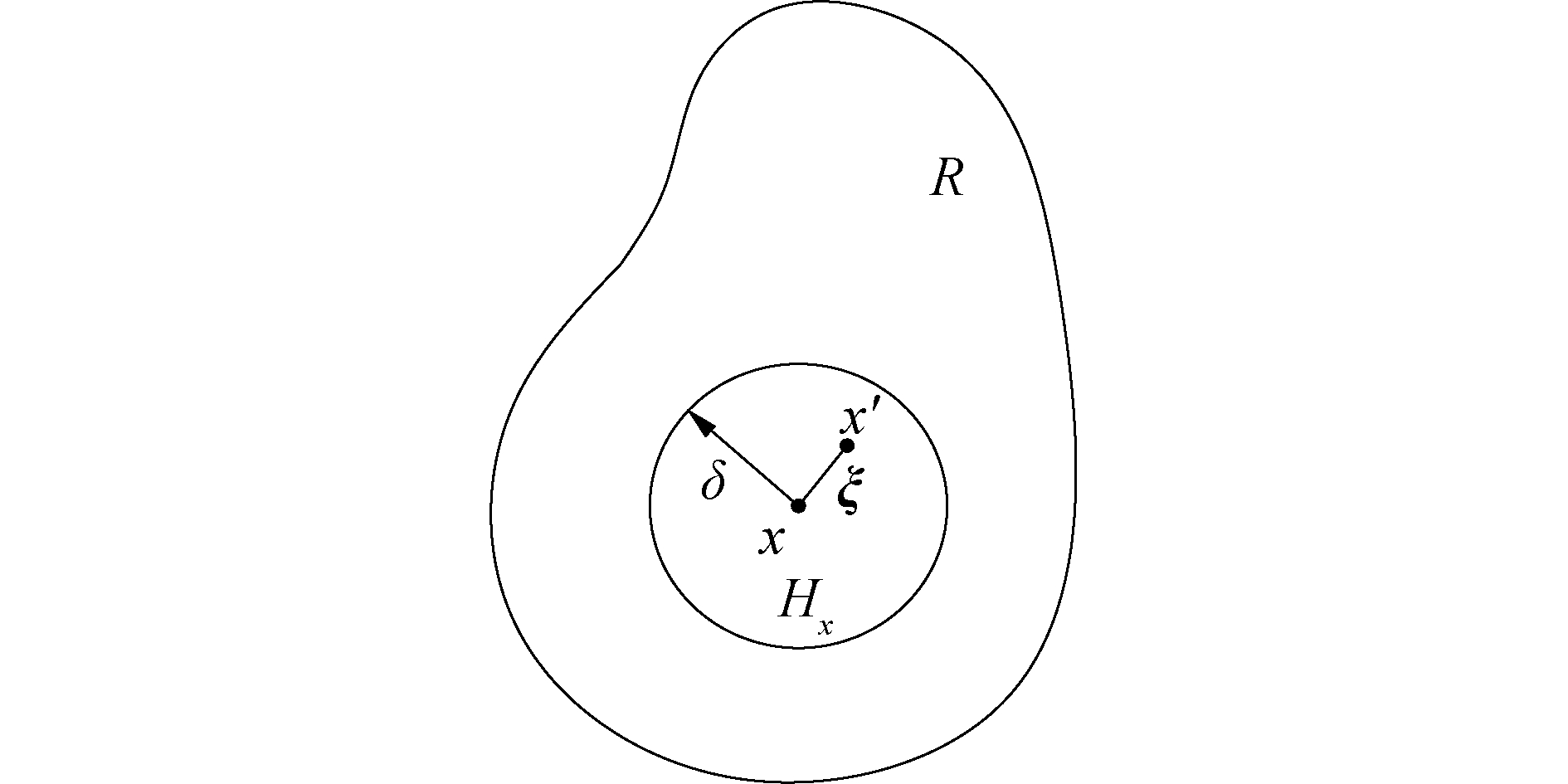
|
Download:
|
| 图 1 近场动力学理论相互作用示意 Fig. 1 Schematic diagram of interaction in peridynamic | |
式中:ρ为材料密度;f为物质点x与物质点x′之间的“力密度函数”;u代表物质点的位移矩阵;Hx表示以物质点x为中心且邻域半径δ划定的近场范围;b为施加在物质点x上的体积力。
弹脆性材料的作用力密度f(η, ξ)可表示为[15]:
| $ f(\mathit{\boldsymbol{\eta }}, \mathit{\boldsymbol{\xi }}) = \mathit{cs}\mathit{\boldsymbol{\mu }}(t, \mathit{\boldsymbol{\xi }}) \cdot \frac{{\mathit{\boldsymbol{\xi }} + \mathit{\boldsymbol{\eta }}}}{{|\mathit{\boldsymbol{\xi }} + \mathit{\boldsymbol{\eta }}|}} $ | (2) |
式中:ξ、η分别代表物质点对的初始相对位置和相对位移。
| $ \mathit{\boldsymbol{\xi }} = \mathit{\boldsymbol{x}} - \mathit{\boldsymbol{x}}' $ | (3) |
| $ \mathit{\boldsymbol{\eta }} = \mathit{\boldsymbol{u}}\left( {\mathit{\boldsymbol{x}}', t} \right) - \mathit{\boldsymbol{u}}\left[ {\mathit{\boldsymbol{x}}, t} \right] $ | (4) |
c为微弹性模量。对于三维问题的数值模拟[12],有:
| $ c = \frac{{18K}}{{{\rm{ \mathsf{ π} }}{\delta ^4}}} $ | (5) |
式中:K为体积模量;s为“键”伸长率[12],为:
| $ s = \frac{{|\mathit{\boldsymbol{\xi }} + \mathit{\boldsymbol{\eta }}| - |\mathit{\boldsymbol{\xi }}|}}{{|\mathit{\boldsymbol{\xi }}|}} $ | (6) |
对于各向同性材料,当物质点对的“键”处于拉伸状态时,s > 0;反之若为压缩状态,s < 0。
而μ(t, ξ)为一用来表示“键”状态的标量。
| $ \mu \left( {t, \mathit{\boldsymbol{\xi }}} \right) = \left\{ {\begin{array}{*{20}{l}} {1, }&{s\left( {t', \mathit{\boldsymbol{\xi }}} \right) < {s_0}}\\ {0, }&{s\left( {t', \mathit{\boldsymbol{\xi }}} \right) \ge {s_0}} \end{array}} \right. $ | (7) |
式中:s0为临界伸长率。当“键”伸长率达到s0时,认为“键”发生断裂。反之则没有发生破坏。
此外,Silling还提出了描述物质点局部损伤程度的物理量[12]:
| $ \varphi \left( {\mathit{\boldsymbol{x}}, t} \right) = 1 - \frac{{\int_{{H_x}} \mu (\mathit{\boldsymbol{x}}, t, \mathit{\boldsymbol{\xi }}){\rm{d}}{V_\xi }}}{{\int_{{H_x}} {\rm{d}} {V_\xi }}} $ | (8) |
φ取值范围为0~1。当φ=0时,表明物质点保持完好状态;当φ=1时,说明该物质点与其近场范围内的所有物质点之间均不再存在相互作用。
在数值计算时,需将连续体在笛卡尔坐标系下离散为空间内的一系列物质点,同时将求解空间积分方程转化为求解有限和的形式。其基本方程为:
| $ \rho {{\mathit{\boldsymbol{\ddot u}}}_i} = \sum\limits_{j = 1}^n \mathit{\boldsymbol{f}} \left( {{\mathit{\boldsymbol{u}}_j} - {\mathit{\boldsymbol{u}}_i}, {\mathit{\boldsymbol{x}}_j} - {\mathit{\boldsymbol{x}}_i}} \right){V_j} + {\mathit{\boldsymbol{b}}_i} $ | (9) |
式中:xj为位于物质点xi近场范围Hx内的物质点;ui、uj分别为物质点xi和xj的位移;
海冰的力学性质易受温度、孔隙度、盐度以及加载速率等影响。如图 2所示,应变率对海冰的压缩强度影响显著[16]。在海冰与柱状结构的相互作用中,当加载速率较低时,冰力呈准静态特点,海冰体现为韧性材料;当加载速率较高时,冰力呈随机性特点,海冰材料呈脆性破坏;而在中等加载速率下,冰力则呈稳态特性,海冰材料处于韧-脆转换状态[17]。考虑到本文算例中所选取的冰速,重点考虑海冰的脆性破坏,在计算模型中将海冰视为弹脆性材料,满足线弹性本构关系。

|
Download:
|
| 图 2 海冰材料特性随应变速率的变化特征 Fig. 2 Characteristic variety of sea ice with strain rates | |
此外,海冰在较高应变率下的脆性破坏呈现出较明显的拉压异性。相关实验数据显示,冰的压缩强度一般为拉伸强度的3~5倍[18],此处取sc=-4·st,其中st和sc分别为冰材料临界拉伸、压缩率。海冰的PD材料本构关系如图 3所示。

|
Download:
|
| 图 3 海冰材料本构关系 Fig. 3 Constitutive relation of sea ice | |
海冰发生韧-脆转换时对应的应变率约在1.0×10~3.0×10-3 s-1[19]。根据文献[20-23]中渤海冰的相关实验数据统计发现,海冰在韧-脆转换范围内压缩强度极值近似为脆性区压缩强度极值的1.3~2倍。本文取韧-脆转换状态下海冰的临界压缩率为脆性状态下的1.8倍。
2.2 临界伸长率s0近场动力学方法通过s0判定材料是否发生断裂,可由其与断裂面的能量释放率G0关系进行推导。
| $ {s_0} = \sqrt {\frac{{10{G_0}}}{{{\rm{ \mathsf{ π} }}c{\delta ^5}}}} = \sqrt {\frac{{5{G_0}}}{{6E\delta }}} $ | (10) |
式中:E为弹性模量;G0可通过线弹性断裂力学进行推导[24]:
| $ {G_0} = K_{\mathit{IC}}^2/E $ | (11) |
式中:KIC为断裂韧度,可通过实验测量等方法确定,以此建立s0与KIC之间的关系:
| $ {s_0} = \sqrt {\frac{5}{{6\delta }}} \cdot \frac{{{K_{IC}}}}{E} $ | (12) |
季顺迎等基于渤海海冰断裂韧度实验结果,归纳出断裂韧度KIC与温度T之间的拟合关系[25]:
| $ {K_{IC}}{\rm{ = - 9}}{\rm{.293}}\mathit{T}{\rm{ + 76}}{\rm{.366}} $ | (13) |
根据Parks等所述,计算物体间的接触力时需引入短程排斥力,以避免不同物体的物质点占据相同空间位置[15]。当两粒子间距小于短程排斥力临界范围dp时,粒子间相互排斥力密度函数fs为:
| $ \begin{array}{l} {f_s}\left( {{y_p}, {y_i}} \right) = \min \left\{ {0, \;\;\;\frac{{{c_s}}}{\delta }\left( {\left| {{y_p} - {y_i}} \right| - {d_p}} \right)} \right\} \cdot \\ \;\;\;\;\;\;\;\;\;\;\;\;\;\;\;\;\;\;\;\;\;\;\;\;\;\;\;\frac{{{y_p} - {y_i}}}{{\left| {{y_p} - {y_i}} \right|}} \end{array} $ | (14) |
式中:p和i分别为来自不同物体上的粒子;cs为短程力常数。依据经验,
| $ {c_s} = 15 \cdot \frac{{18K}}{{{\rm{ \mathsf{ π} }}{\delta ^4}}} $ | (15) |
| $ {d_p} = \min \left\{ {0, 9\left| {{x_p} - {x_i}} \right|, 1.35\left( {{r_p} + {r_i}} \right)} \right\} $ | (16) |
式中rp和ri分别代表粒子p和i的物质点半径。
2.4 桩腿振动模型如图 4所示,桩腿被简化为具有一定质量M、结构刚度K和阻尼系数C的振动结构,受海冰作用产生水平x方向的振动,满足单自由度振动的动力学方程:
| $ M \cdot \ddot u + C \cdot \dot u + K \cdot u = {F_c} $ | (17) |
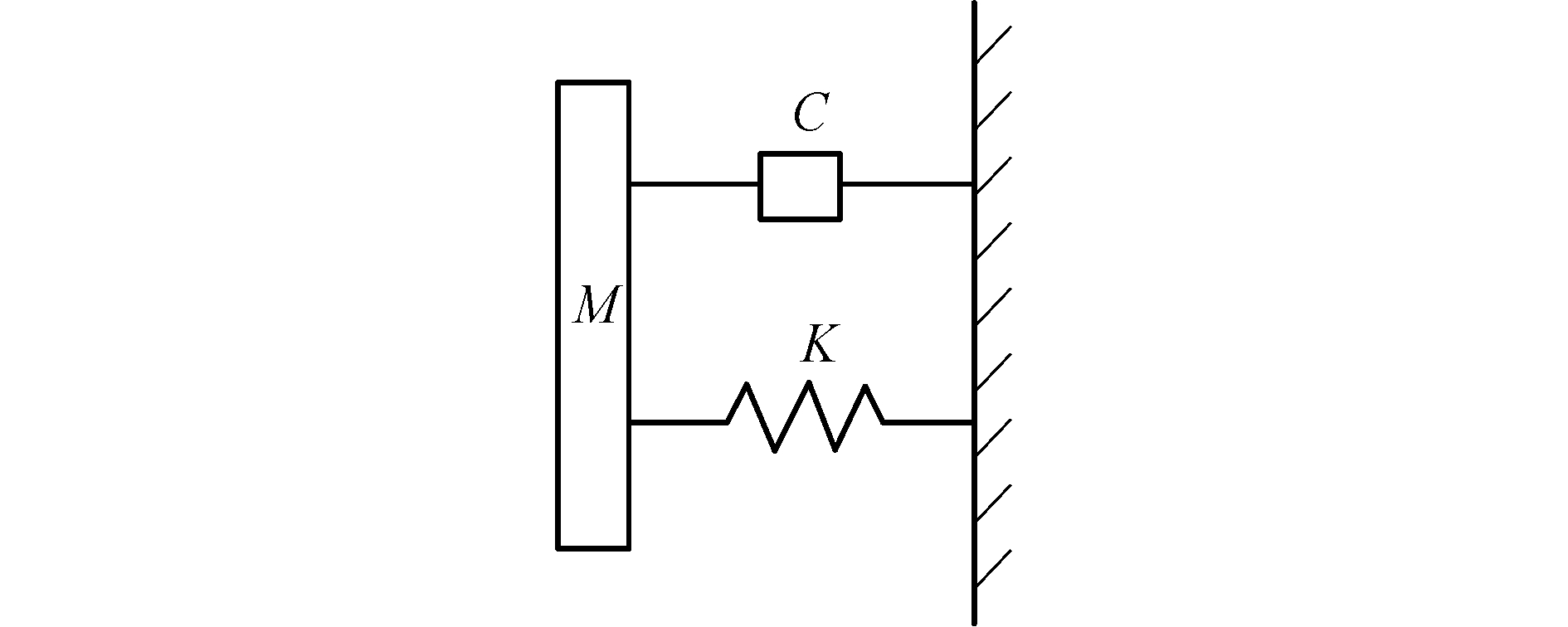
|
Download:
|
| 图 4 结构振动模型 Fig. 4 Vibration model of the structure | |
式中Fc表示柱状结构与海冰之间的接触力。
2.5 计算方法海冰粒子的运动采用向后差分法进行求解。在第n步时,
| $ \ddot u_i^n = \frac{{f_i^n + b_i^n}}{{{\rho _i}}} $ | (18) |
| $ \dot u_i^n = \dot u_i^{n - 1} + \ddot u_i^n \cdot \Delta t $ | (19) |
| $ u_i^n = u_i^{n - 1} + \dot u_i^n \cdot \Delta t $ | (20) |
根据文献[12],时间步长需满足:
| $ \Delta t < \sqrt {\frac{{2\rho }}{{\sum\nolimits_j {{C_{ij}}} {V_j}}}} $ | (21) |
式中
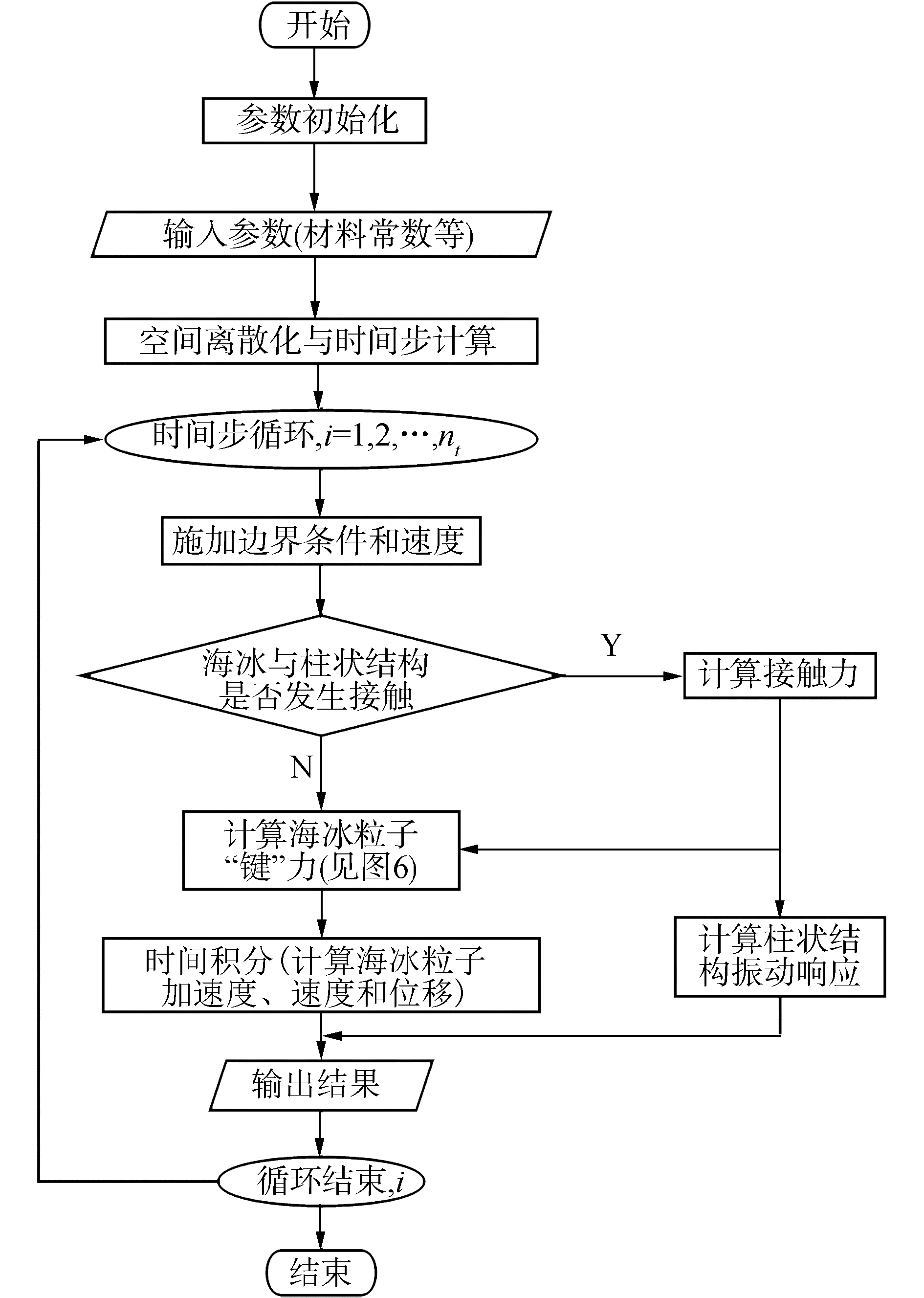
|
Download:
|
| 图 5 数值模拟计算流程 Fig. 5 Flow chart of numerical simulation | |
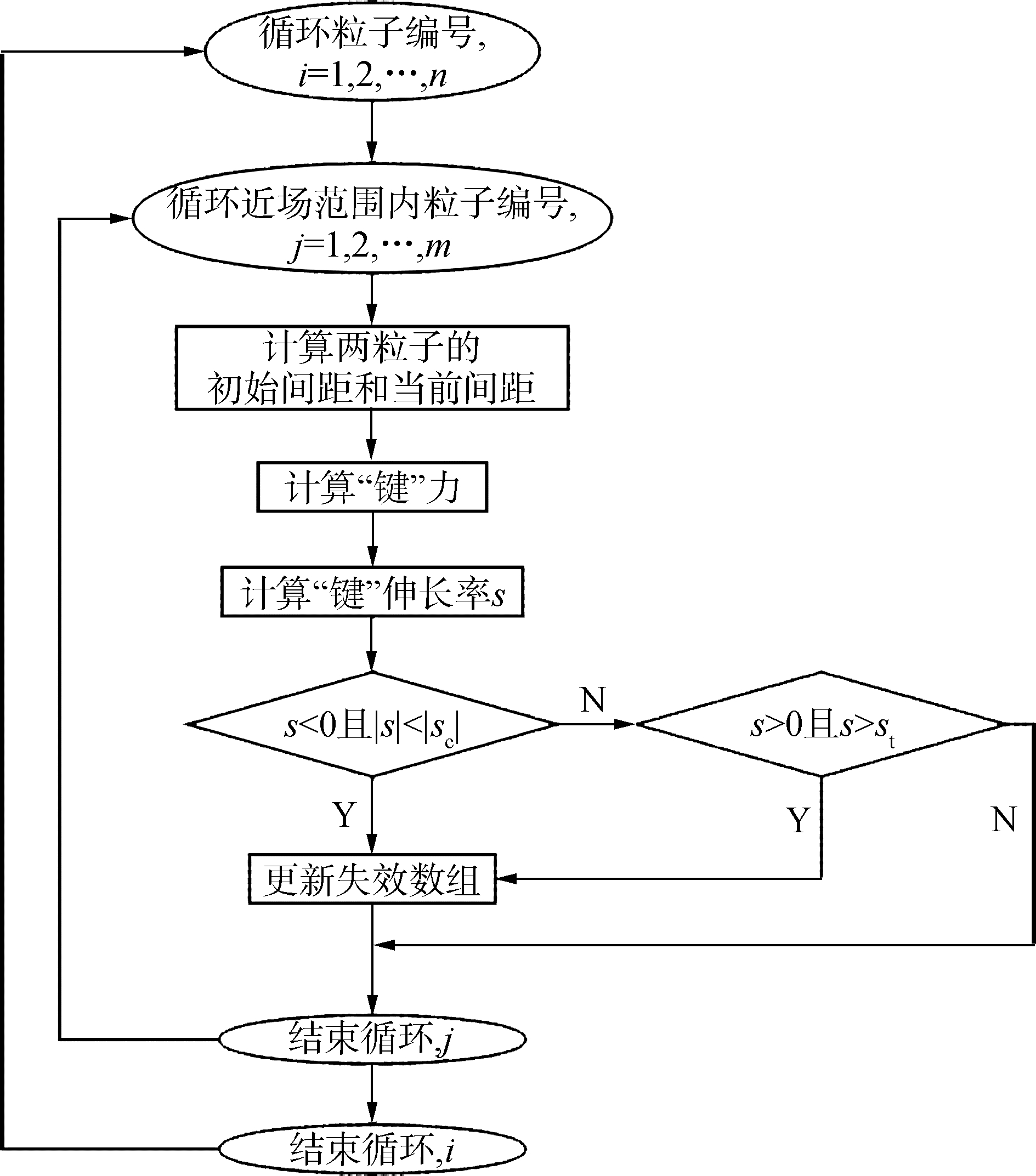
|
Download:
|
| 图 6 “键”力计算方法 Fig. 6 Computation method of the bond force | |
数值模拟主要参数取自文献[14],如表 1所示。海冰厚度方向划分3层粒子,粒子尺寸Δx约为0.087 m,取近场范围δ为3·Δx,时间步长Δt为1.0×10-4s。为体现海冰半无限宽特性并忽略边界的影响,除与桩腿发生接触的一面处于自由状态之外,其他三面均作刚固处理。取桩腿移动的方向为坐标系x轴正向,计算模型如图 7所示。
| 表 1 计算参数 Table 1 Calculation parameters |
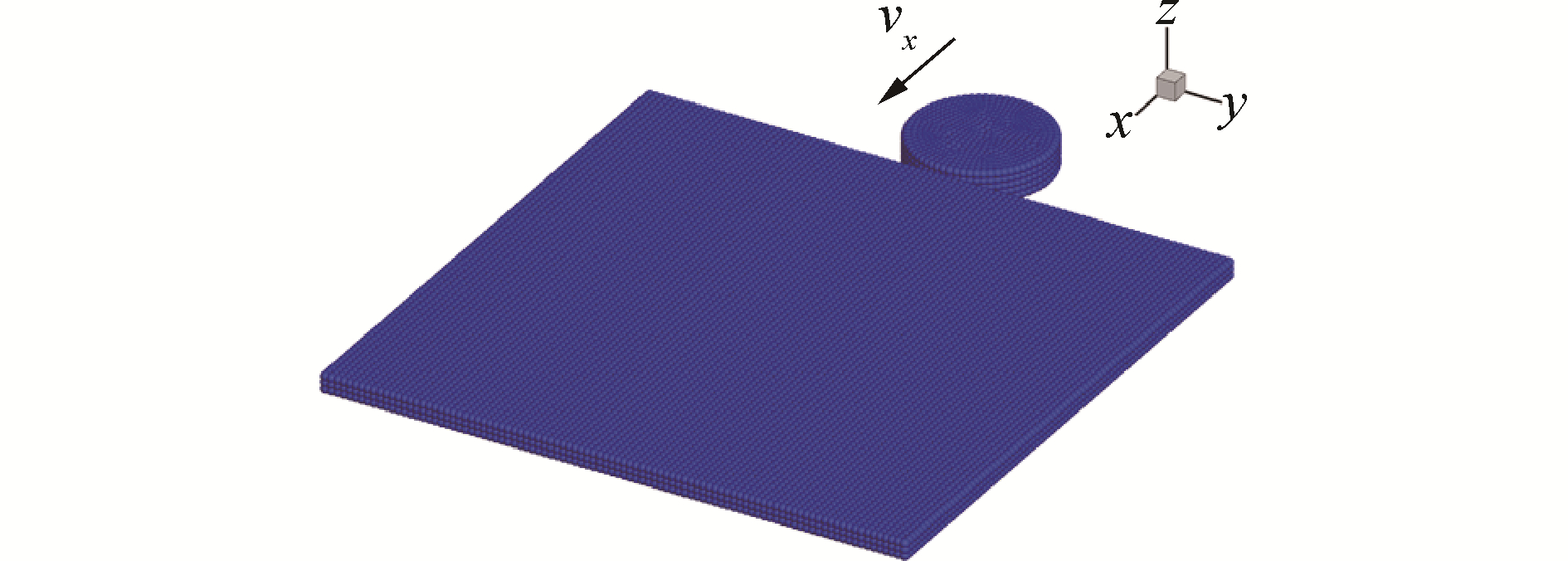
|
Download:
|
| 图 7 海冰与柱状结构相互作用的数值模型 Fig. 7 Numerical model of the interaction between the sea ice and cylindrical structure | |
图 8、9分别给出了黄焱等的海冰与柱状结构相互作用的实验现象以及本文数值计算得到的效果图。通过对比发现,近场动力学数值模型能够较为合理地反映海冰在此过程中的挤压破碎现象。

|
Download:
|
| 图 8 海冰与直立桩腿相互作用的实验现象[26] Fig. 8 Experimental phenomenon of interaction between sea ice and cylindrical structure[26] | |
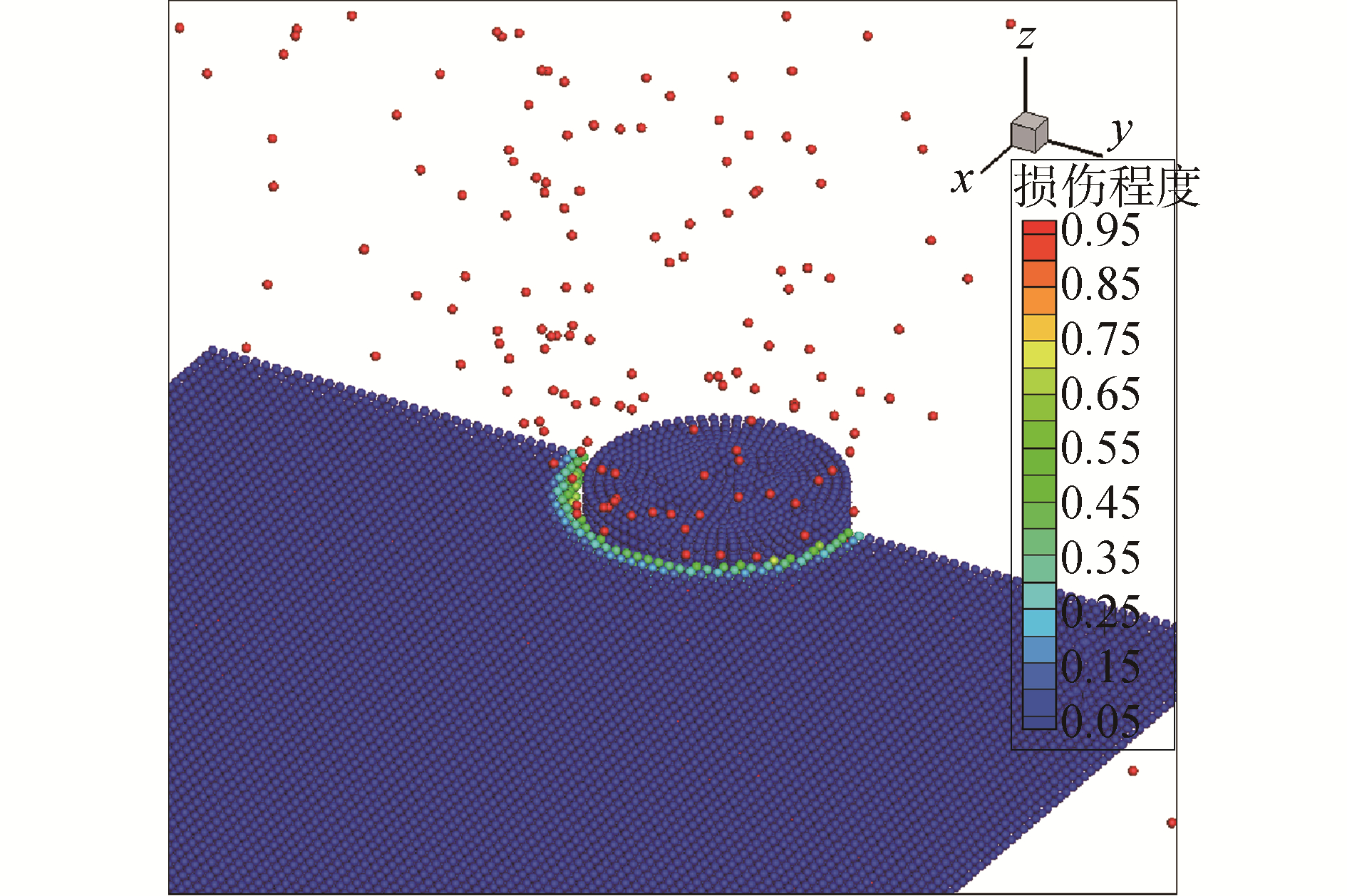
|
Download:
|
| 图 9 数值模拟可视化效果图(第21 400步) Fig. 9 Virtual reports of the numerical simulation(step 21 400) | |
0.5 m/s冰速下柱状结构所受水平冰载荷时程变化如图 10(a)所示。此外,增加采样频率,在图 10(b)中给出了4.8~6 s内的冰载荷细节。根据图像,水平冰力呈无规律的加、卸载随机性特点。计算得到的柱状结构振动响应时程如图 11所示。

|
Download:
|
| 图 10 水平冰力的时程变化 Fig. 10 Horizontal ice force during the simulation | |

|
Download:
|
| 图 11 振动响应的时程变化 Fig. 11 Vibration response of structure during the simulation | |
表 2给出了在相互作用过程中计算得到的水平冰力、柱状结构振动位移及振动加速度的数据分析结果,同时与文献[14]中计算得到的结果进行了对比。经分析,通过PD方法计算得到的冰载荷与柱状结构的振动响应与文献[14]中的计算结果吻合较好,验证了计算方法的合理性。
| 表 2 PD计算结果与文献[14]计算结果的对比 Table 2 Comparision of results calculated by Peridynamics and from literature [14] |
对1.2 m、1.6 m和2.4 m桩径下海冰与柱状结构相互作用进行了数值模拟,冰速仍取0.5 m/s,其他计算参数不变,同3.1节所述。水平冰力与结构振动位移计算结果分别如表 3~4所示。
| 表 3 不同桩径作用下水平冰力的计算结果 Table 3 Horizontal ice forces with various diameters of cylindrical structure |
| 表 4 不同桩径作用下结构振动位移的计算结果 Table 4 Structure vibration displacements with various diameters of cylindrical structure |
如图 12(a)所示,水平冰力整体随桩腿直径增大呈增加趋势。考虑当桩径较大时,两者间接触区域较大,导致了随机冰力的增大。如图 12(b)所示,对比不同桩腿直径下结构的振动响应发现,结构振动位移极值和均值均随桩径增加而增加。考虑桩径增大提升了冰力值总体水平,增大了振动系统外力输入,进而导致了振动响应的增大。

|
Download:
|
| 图 12 桩径的影响规律 Fig. 12 The effect of diameter of cylindrical structure | |
此外,如图 13所示,计算发现Fmax/Fmean随径厚比D/h增大逐渐减小,与Sodhi的实验结果一致,符合Kry提出的冰载荷极值与均值随着结构宽度增加逐渐接近的观察结果[26]。

|
Download:
|
| 图 13 Fmax/Fmean与D/h的关系 Fig. 13 Ratio of maximum force to mean force Fmax/Fmean versus the ratio of diameter to ice thickness D/h | |
分别取冰速0.2、0.8和1.1 m/s进行计算,桩径仍取2 m,其他参数保持不变。水平冰力、结构振动位移计算结果分别如表 5~6所示。
| 表 5 不同冰速下水平冰力的计算结果 Table 5 Horizontal ice forces with various moving velocities of sea ice |
| 表 6 不同冰速下结构振动位移的计算结果 Table 6 Structure vibration displacements with various moving velocities of sea ice |
如图 14(a)所示,水平冰力总体随冰速增大而增大,但增速逐渐放缓,0.5、0.8和1.1 m/s下冰力均值十分接近。而冰速0.2 m/s时水平冰力极值较0.5 m/s时较高,与Sodhi和Morris的平板冰与刚性立柱结构接触实验结果具有一定的相似性[27]。如图 14(b)所示,振动位移均值随冰速增大而增大,但极值却随冰速呈负增长趋势。通过对比各冰速下结构的振动位移时程曲线发现,0.8和1.1 m/s下结构振动位移曲线同0.5 m/s时类似,均呈随机性。但0.2 m/s下结构振动位移幅值持续维持在0.2~0.4 mm,且具有较明显的周期性特点,如图 15所示。因此,认为在0.2 m/s冰速下柱状结构的振动为稳态振动。

|
Download:
|
| 图 14 冰速的影响规律 Fig. 14 The effect of moving velocities of sea ice | |
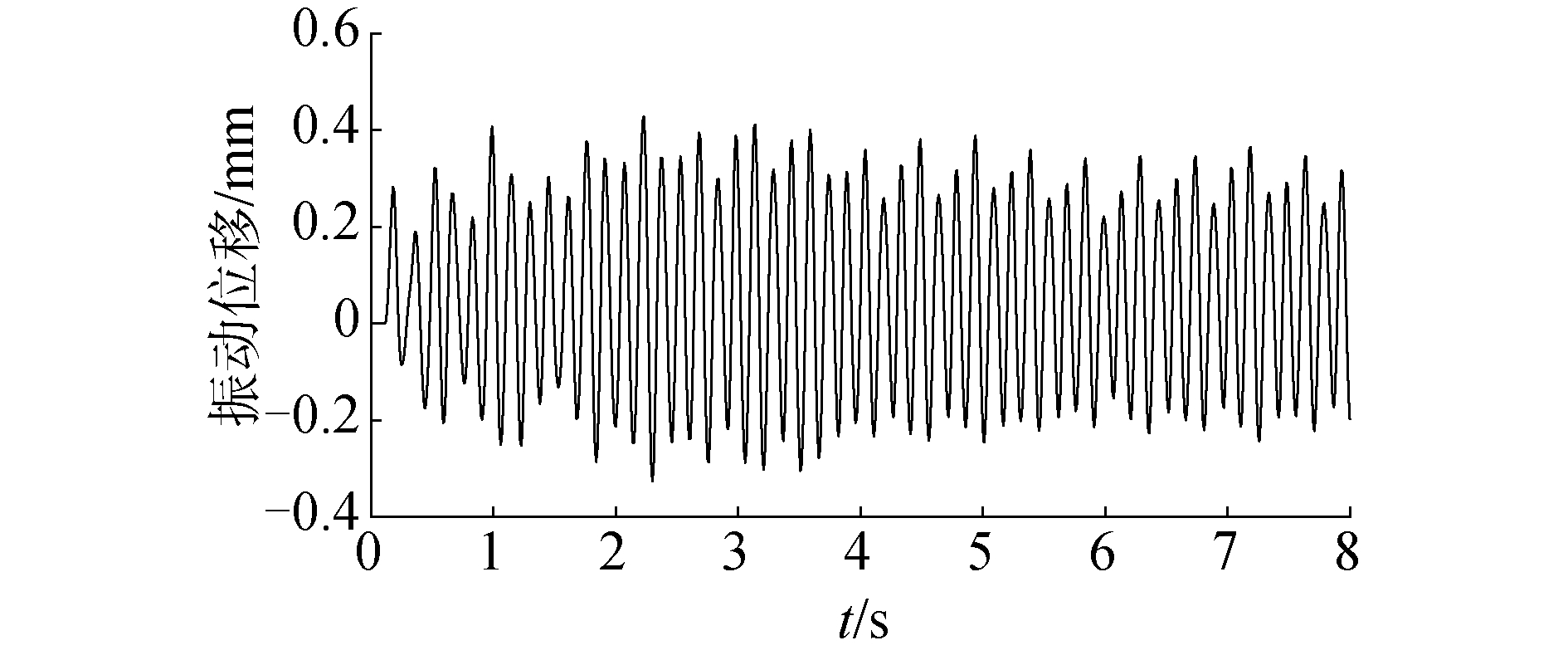
|
Download:
|
| 图 15 结构振动位移的时程变化(0.2 m/s) Fig. 15 Vibration displacement of cylindrical structure during the simulation (0.2 m/s) | |
黄焱等[27]的实验结果显示,当柱状结构与海冰相互作用发生稳态振动时,结构振动位移主频与结构的自振频率近似。对0.2 m/s冰速下的柱状结构振动位移时程数据进行快速傅里叶变换(FFT),计算结果如图 16所示。由图可知,结构振动位移在频域上具有6.625 Hz的主频,与系统自振频率6.497 Hz相近,验证了结构发生稳态振动。

|
Download:
|
| 图 16 结构振动位移频域分析结果 Fig. 16 Analysis results of structure vibration displacements in frequency domain | |
此外,计算了冰载荷极值与均值的比值Fmax/Fmean随冰速-厚度比v/h的变化关系,其结果如图 17所示。

|
Download:
|
| 图 17 Fmax/Fmean与v/h的关系 Fig. 17 Ratio of maximum force to mean force Fmax/Fmean versus the ratio of velocity to ice thickness v/h | |
由图 17可知,Fmax/Fmean随着v/h增大呈微幅减小的趋势,这与Sodhi的实验结果相一致[27]。
5 结论1) 总体来说,海冰与柱状结构相互作用引发的水平冰载荷与桩径、冰速呈正相关关系。结构的振动位移随着桩径增大而增大,随着冰速增大而减小。
2) 柱状结构发生稳态振动时,其结构振动位移具有较为明显的主频且与系统自振频率近似。
3) 挤压过程中,冰载荷极值与均值的比值Fmax/Fmean随着D/h和v/h的增大逐渐减小,其中随v/h的变化幅度较小。
| [1] |
NEILL C R. Dynamic ice forces on piers and piles. An assessment of design guidelines in the light of recent research[J]. Canadian journal of civil engineering, 1976, 3(2): 305-341. DOI:10.1139/l76-030 (  0) 0)
|
| [2] |
MÄÄTTÄNEN M. Stability of self-excited ice-induced structural vibrations[C]//Proceedings of 4th International Conference on Port and Ocean Engineering Under Arctic Conditions. St. John's Newfoundland, Canada, 1977: 684-694.
(  0) 0)
|
| [3] |
MARTONEN P, DERRADJI-AOUAT A, MÄÄTTÄNEN M, et al. Non-linear finite elements simulations of level ice forces on offshore structures using a multi surface failure criterion[C]//Proceedings of the 17th International Conference on Port and Ocean Engineering Under Arctic Conditions. Trondheim, Norway, 2003.
(  0) 0)
|
| [4] |
HILDING D, FORSBERG J, GÜRTNER A. Simulation of ice action loads on off shore structures[C]//Proceedings of the 8th European LS-DYNA Users Conference. Strasbourg, France, 2011: 1-12.
(  0) 0)
|
| [5] |
武文华, 于佰杰, 岳前进, 等. JZ20-2NW平台抗冰性能的有限元分析[J]. 中国海洋平台, 2007, 22(6): 25-28, 33. WU Wenhua, YU Baijie, YUE Qianjin, et al. FEM analysis for ice-induce vibration of JZ20-2NW platform[J]. China offshore platform, 2007, 22(6): 25-28, 33. DOI:10.3969/j.issn.1001-4500.2007.06.006 (  0) 0)
|
| [6] |
龚榆峰, 张正艺, 刘敬喜, 等. 基于ABAQUS的海冰单元开发及冰载荷直接计算法[J]. 中国舰船研究, 2017, 12(3): 75-85. GONG Yufeng, ZHANG Zhengyi, LIU Jingxi, et al. Development of sea ice element and direct analysis method of predicting ice loads based on ABAQUS[J]. Chinese journal of ship research, 2017, 12(3): 75-85. DOI:10.3969/j.issn.1673-3185.2017.03.011 (  0) 0)
|
| [7] |
PAAVILAINEN J, TUHKURI J, POLOJÄRVI A. Discrete element simulation of ice pile-up agaist an inclined structure[C]//Proceedings of the 18th IAHR International Symposium on Ice. Dunedin, New Zealand, 2006.
(  0) 0)
|
| [8] |
LAU M. A three dimensional discrete element simulation of ice sheet impacting a 60° conical structure[C]//Proceedings of the 16th International Conference on Port and Ocean Engineering Under Arctic Conditions. Ottawa, Canada, 2001.
(  0) 0)
|
| [9] |
狄少丞.基于GPU并行算法的海洋平台及船舶结构冰荷载的离散元分析[D].大连: 大连理工大学, 2015. DI Shaocheng. Discrete element simulation of ice load on offshore platform and ship hull based on GPU parallel algorithm[D]. Dalian: Dalian University of Technology, 2015. http://cdmd.cnki.com.cn/Article/CDMD-10141-1016033605.htm (  0) 0)
|
| [10] |
邵帅, 周国丰, 王帅霖, 等. 基于离散元-有限元模型的冰激锥体海洋平台结构振动分析[J]. 计算力学学报, 2015, 32(5): 662-667. SHAO Shuai, ZHOU Guofeng, WANG Shuailin, et al. Ice induced vibration of concial offshore platform structure based on discrete element model-finite element model[J]. Chinese journal of computational mechanics, 2015, 32(5): 662-667. (  0) 0)
|
| [11] |
SILLING S A. Reformulation of elasticity theory for discontinuities and long-range forces[J]. Journal of the mechanics and physics of solids, 2000, 48(1): 175-209. DOI:10.1016/S0022-5096(99)00029-0 (  0) 0)
|
| [12] |
SILLING S A, ASKARI E. A meshfree method based on the peridynamic model of solid mechanics[J]. Computers & structures, 2005, 83(17/18): 1526-1535. (  0) 0)
|
| [13] |
黄丹, 章青, 乔丕忠, 等. 近场动力学方法及其应用[J]. 力学进展, 2010, 40(4): 448-459. HUANG Dan, ZHANG Qing, QIAO Pizhong, et al. A review on peridynamics (PD) method and its applications[J]. Advances in mechanics, 2010, 40(4): 448-459. (  0) 0)
|
| [14] |
季顺迎, 狄少丞, 李正, 等. 海冰与直立结构相互作用的离散单元数值模拟[J]. 工程力学, 2013, 30(1): 463-469. JI Shunying, DI Shaocheng, LI Zheng, et al. Discrete element modelling of interaction between sea ice and vertical offshore structures[J]. Engineering mechanics, 2013, 30(1): 463-469. (  0) 0)
|
| [15] |
PARKS M L, PLIMPTON S J, LEHOUCQ R B, et al. Peridynamics with LAMMPS: a user guide. Sandia National Laboratory Report, SAND2008-0135[R]. Albuquerque, New Mexico: Sandia National Laboratories, 2008.
(  0) 0)
|
| [16] |
SCHULSON E M. Brittle failure of ice[J]. Reviews in mineralogy and geochemistry, 2002, 51(1): 201-252. DOI:10.2138/gsrmg.51.1.201 (  0) 0)
|
| [17] |
LIU Minghao, WANG Qing, LU Wei. Peridynamic simulation of brittle-ice crushed by a vertical structure[J]. International journal of naval architecture and ocean engineering, 2017, 9(2): 209-218. DOI:10.1016/j.ijnaoe.2016.10.003 (  0) 0)
|
| [18] |
KARR D G, DAS S C. Ice strength in brittle and ductile failure modes[J]. Journal of Structural Engineering, 1983, 109(12). DOI:10.1061/(ASCE)0733-9445(1983)109:12(2802) (  0) 0)
|
| [19] |
杜小振.冰致柔性直立结构振动的动冰力研究[D].大连: 大连理工大学, 2003. http://cdmd.cnki.com.cn/Article/CDMD-10141-2004093978.htm
(  0) 0)
|
| [20] |
李福成, 孟广琳, 张明元. 应力率对海冰单轴抗压强度的影响[J]. 海洋学报, 1986, 8(5): 619-625. (  0) 0)
|
| [21] |
张明元, 杨国金. 辽东湾北岸海冰物理力学性质[J]. 中国海上油气:工程, 1999, 11(4): 13-20. ZHANG Mingyuan, YANG Guojin. The physical and mechanical properties of sea ice in northern part of Liaodong Bay[J]. China offshore oil and gas (engineering), 1999, 11(4): 13-20. (  0) 0)
|
| [22] |
李洪升, 杜小振, 岳前进. 海冰强度对应变速率敏感性及其演化模式[J]. 大连理工大学学报, 2003, 43(5): 686-690. LI Hongsheng, DU Xiaozhen, YUE Qianjin. Sea ice strength sensitivity to strain rate and its evolution mode[J]. Journal of Dalian University of Technology, 2003, 43(5): 686-690. DOI:10.3321/j.issn:1000-8608.2003.05.032 (  0) 0)
|
| [23] |
陈晓东, 王安良, 季顺迎. 海冰在单轴压缩下的韧-脆转化机理及破坏模式[J]. 中国科学:物理学力学天文学, 2018, 48(12): 124601. CHEN Xiaodong, WANG Anliang, JI Shunying. The study on brittle-ductile transition mechanism and failure mode of sea ice under uniaxial compression[J]. Scientia sinica physica, mechanica & astronomica, 2018, 48(12): 124601. (  0) 0)
|
| [24] |
WANG Qing, WANG Yi, ZAN Yingfei, et al. Peridynamics simulation of the fragmentation of ice cover by blast loads of an underwater explosion[J]. Journal of marine science and technology, 2018, 23(1): 52-66. DOI:10.1007/s00773-017-0454-x (  0) 0)
|
| [25] |
季顺迎, 刘宏亮, 许宁, 等. 渤海海冰断裂韧度试验[J]. 水科学进展, 2013, 24(3): 386-391. JI Shunying, LIU Hongliang, XU Ning, et al. Experiments on sea ice fracture toughness in the Bohai Sea[J]. Advances in water science, 2013, 24(3): 386-391. (  0) 0)
|
| [26] |
SODHI D S, MORRIS C E. Ice forces on rigid, vertical, cylindrical structures[R]. Hanover NH: Cold Regions Research and Engineering Laboratory, 1984.
(  0) 0)
|
| [27] |
HUANG Yan, SHI Qingzeng, SONG An. Model test study of the interaction between ice and a compliant vertical narrow structure[J]. Cold regions science and technology, 2007, 49(2): 151-160. DOI:10.1016/j.coldregions.2007.01.004 (  0) 0)
|
 2020, Vol. 41
2020, Vol. 41


